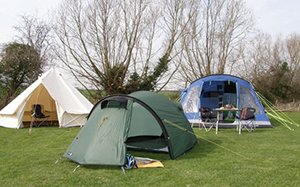There’s still time to take part in our
Tent Owner Satisfaction Survey, and have your say on any tent you’ve bought and owned from new since January 2013.

For starters, everyone who completes the survey will be in with a chance to win a
month’s free camping on Club Sites.
What’s more, you’ll be adding to an invaluable resource, aiding others who’re researching their next tent purchase to buy smarter, and helping us highlight areas of improvement to manufacturers, to raise the overall quality and reliability of tents on sale today.
Our first ever Tent Survey, which we launched last summer and announced the findings on our website
here, taught us plenty about your decision making processes when it comes to parting with your hard-earned cash.
And the good news is, an impressive 83% of respondents said they would buy their chosen make of tent again.
Feedback lists the key reasons people buy a particular tent start with overall size (46%), then ease of pitching (26%). Cost was the third key factor, at 18%. Then came brand reputation (15%), quality (13%), layout (12%) and design (10%) respectively.
The final three of the 10 top aspects were listed as weight (9%), and height/headroom and reviews, both with 8%.
Other factors beyond this top 10 included: price discounts and porch (whether as standard or available as an option).

We also asked what people felt were the most important factors generally when considering buying a tent. Here, waterproofing was rated highest, ahead of number of berths, ventilation and materials used. Next came price and then, with similar scores, were method of pitching, brand reputation and quality of zip.
Weight considerations and reviews completed the top 10 here. As far as the latter was concerned, this referred to independent publication or online reviews and, although not high scores, these did come higher than recommendation by family or friend, or indeed retailer.
From our survey findings, here are our 10 top tips for anyone looking to purchase a tent:
1. Do Your Research
Work out for yourselves everything from the actual size of tent you want to its floorplan. Do you want your tent for your main holiday, weekend breaks or more? Unsurprisingly, many campers own more than one tent.
2. Go See
There’s nothing to beat going to see tents for yourself. Leading retailers will have examples ready-pitched for you to inspect and compare. This is ideal, because it allows you to actually get inside tents and see how they feel.
3. Set your budget
As well as the cost of the tent itself, remember there will be other camping accessories that you will need to budget for. That could extend as far as
insurance. Most of our Tent Survey respondents bought tents in the £301-£500 and £501-£1,000 price brackets (19% in each) – but note this would refer to the price paid rather than manufacturers’ suggested retail prices.
4. Think ‘size matters’
Obviously, the bigger the tent. the more living space you will have on-site. However, larger tents are typically harder to pitch and pack, weigh more and will take up most space for transport and storage. Consider, also, the actual pitch size on offer at where you choose to camp. Remember, berths refers to the number of people who can sleep in a tent, but doesn’t take into account storage space for your gear.
5. Ask for a pitching demonstration
Everyone will have different opinions on how easy, or otherwise, any tent is to pitch. Worse, you don’t really have the opportunity to “try before you buy”, although there is one thing we do recommend – practise putting up your new tent (in the garden, or in a nearby field) before you go away camping with it for the first time.
6. Consider the materials
Not just the main fabric (the flysheet), but also aspects such as the poles and guylines, zips, windows and more came under scrutiny in our survey. Tent pegs came in for some criticism from respondents – check those supplied look up to the job, or be prepared to invest in a superior quality alternative.
7. Take a look at extras

Footprints, carpets, annexes, awnings, porch extensions, and more, are available for many tent models. They’re well worth considering, depending on what type of camping you envisage doing.
8. Ask around
Camping and Caravanning Club members, in particular, buy into the whole Friendly Club ethos and are more than happy to offer advice, as appropriate. Look out, also, for independent reviews – either online or in specialist publications – and be aware of the authenticity of such reports.
9. Keep a look out for promotions
Our research also suggests as many as three-quarters of buyers benefited from special offers. Just as importantly, do look out for special offers on tent packages, where extras like carpet, footprints and more are included.
10. Learn the lingo
As with any specialist product, there’s a bit of jargon to learn, which helps with understanding what you’re getting into. For example, hydrostatic head gives an indication of how waterproof a tent is likely to be. Berths (or persons) relate to how many people a tent can sleep. Factors such as overall dimensions, pack size and weight speak for themselves.
We’re here to help
The Camping and Caravanning Club is the largest and longest established organisation in the world for tent campers. We have been looking after campers for over 100 years. You can find out more on the
Club's website.
Also, the Club publishes
Data Sheets on all the key aspects of camping and caravanning. These are available to non-members and members. These include: Choosing a Tent Layout, Choosing a Tent Material and Looking After Your Tent.